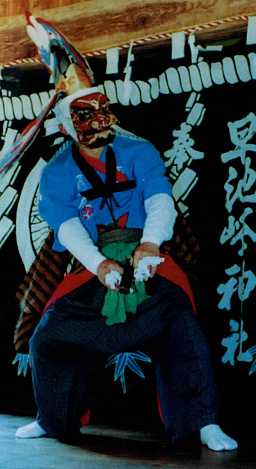| Cast | Kaneto Ito, Tomomi Oguni, Mitsuhiro Oguni, Naoshi Yamada, Mamoru Kambayashi, Kazuo Kamatsuda, Koki Fujiwara, Eiji Ito, Kazuyuki Yanagida, Ryo Ito |


Kagura the national Japanese theatre art developed on the basis of sacred rural holidays. In ancient times the Japanese worshipped shamans. Shamans were, in a condition of ecstasy, inhabited by the gods and they communicating with the spirits of the dead and calmed them. Gradually these rituals turned to the theatrical art ‘kagura’, which has the purpose of praying for the restoration of the forces of life. The art of kagura remains to date a ritual. The dances of kagura are performed with the aim of consoling the spirits.
Hajachine-take-kagura is a ritual dance performed by the mountain priests and offered to the goddess of Mount Hajachine. This dance, which has appeared before the 14th century, has arisen from prayer to the goddess, and until today it is performed almost in the same style. The dancers wear masks representing different gods. The dance is performed to the music of Shinto, which over many centuries has been handed down from priest to priest. Kagura is performed at the foot of Mt. Hajachine, a sacred mountain, at the beginning and end of each year, on the opening day of a new climbing season, and also during the Hayachine Shrine Festival. Besides, the dance is performed on weddings and on Toshi Ivai, the ceremony that protects people from evil forces when they grow old.
'Hajachine-take-kagura'. In 1976 the art of Hajachine-take-kagura was granted the rank of a national cultural heritage of the non-material form of the first degree. The theatre gives 50-60 performances per year, including Japanese and foreign tours. The collective participates in theatrical celebrations, representations devoted to temple holidays, various rituals (Mon-uchi, the arrival of the God Gongen: the troupe visits houses with the God Gongen, the wooden head of a lion, and execute the ritual of expulsion of the evil spirits, Sodzen-ivai and Sanaburi, and say prayers for a rich harvest), and in festivals and competitions of kagura.

